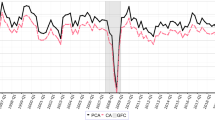Abstract
This study examines the long-run relationship among the per capita private, public, and total health care expenditure and per capita gross domestic product and population growth of Turkey. We find some evidence of multivariate cointegrating relationships among the health care expenditure and gross domestic product, and population growth. We further find a bivariate cointegrating relationship between private health care expenditure and per capita gross domestic product. Accordingly, a 10% increase in gross domestic product would translate into a 21.9% increase in total health care expenditure while controlling population growth. The income elasticity of health expenditure is found to be greater than 1, implying that health care is a luxury good in Turkey. Finally we note that there exists one-way causality running from per capita gross domestic product to various definitions of health care expenses.
Similar content being viewed by others
References
Abel-Smith B (1994) An introduction to health policy, planning and financing. Longman: New York
Blomqvist AG, Carter RAL (1997) Is health care really a luxury? J Health Econ 16: 207–230
Dickey DA, Fuller W (1979) Distribution of the estimators for autoregression time series with a unit root. J Am Stat Assoc 74: 427–431
Dickey DA, Fuller W (1981) Likelihood ratio statistics for autoregressive time series with a unit root. Econometrica 49: 1058–1072
Engle RF, Granger CW (1987) Co-integration an error correction: representation, estimation, and testing. Econometrica 55: 251–276
Feldstein PJ (1979) Health care economics. Wiley: New York
Gerdtham UG, Löthgren M (2000) On stationarity and co-integration of international health expenditure and GDP. J Health Econ 19: 461–475
Hansen P, King A (1996) The determinants of health care expenditure: a co-integration approach. J Health Econ 15: 127–137
Hitiris T, Posnett J (1992) The determinants and effects of health expenditure in developed countries. J Health Econ 11: 173–181
Johansen S (1988) Statistical analysis of co-integration vectors. J Econ Dyn Control 12: 231–254
Johansen S, Juselius K (1990) Maximum likelihood estimation and inference on co-integration with applications to the demand for money. Oxford Bull Econ Stat 52: 169–210
Jones CI (2002) Why have health expenditure as a share of GDP risen so much? NBER working paper no 9325
Jowett M (1999) Bucking the trend? health care expenditure in low income countries 1990–1995. Int J Health Plan Manage 14: 269–285
MacDonald G, Hopkins S (2002) Unit root properties of health care expenditure and GDP data. Health Econ 11: 371–376
MacKinnon JG (1991) Critical values for co-integration tests in long-run econometric relationships. In: Engle F, Granger CWJ (eds) Readings in co-integration. Oxford
McCoskey SK, Selden TH (1998) Health care expenditures and GDP: panel data unit test results. J Health Econ 17: 369–376
Milne R, Molana H (1991) On the effect of income and relative price on demand for health care: EC evidence. Appl Econ 23: 1221–1226
Newhouse JP (1977) Medical care expenditure: a cross-national survey. J Hum Resour 12: 115–125
Osterwald-Lenum MA (1992) Note with quintiles of the asymptotic distribution of the maximum likelihood co-integration rank test statistics. Oxford Bull Econ Stat 54: 461–472
Parkin D, McGuire A, Yule B (1987) Aggregate health care expenditure and national income: is health care a luxury good? J Health Econ 6: 109–127
Phillips PCB, Perron P (1988) Testing for a unit root in time series regression. Biometrika 75: 335–346
Author information
Authors and Affiliations
Corresponding author
Rights and permissions
About this article
Cite this article
Kiymaz, H., Akbulut, Y. & Demir, A. Tests of stationarity and cointegration of health care expenditure and gross domestic product. Eur J Health Econ 7, 285–289 (2006). https://doi.org/10.1007/s10198-006-0375-9
Issue Date:
DOI: https://doi.org/10.1007/s10198-006-0375-9




